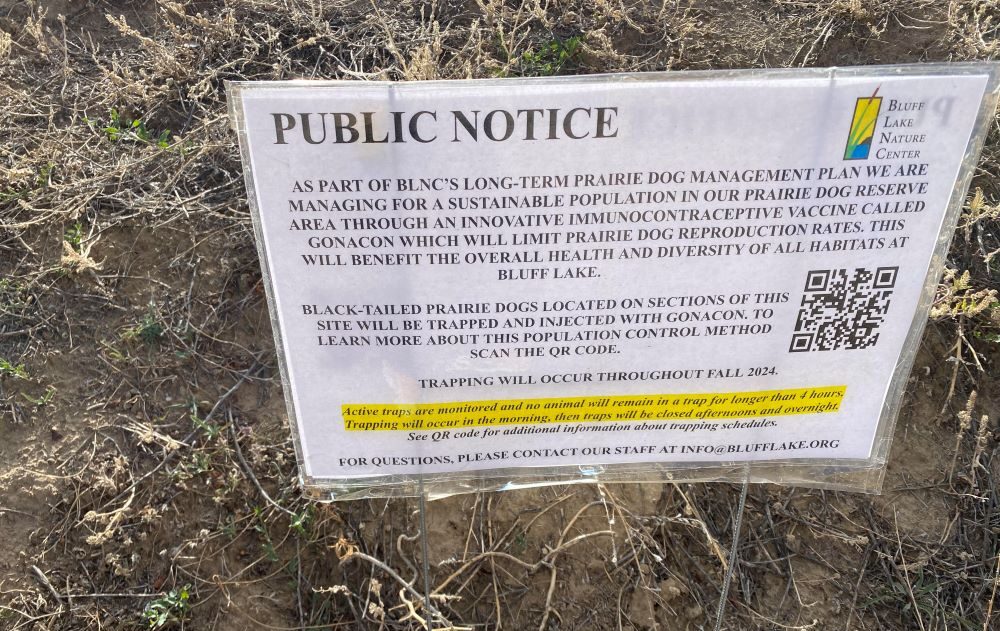
A sign along the trail at Bluff Lake Nature Center alerts visitors to prairie dog population control. Front Porch photo by Linda Kotsaftis
Prairie dogs are going to do what prairie dogs do—reproduce very rapidly. Now, at the Bluff Lake Nature Center (BLNC) in Denver, the animals can do what they want in their dirt tunneled colonies, but they can’t keep reproducing.
BLNC is now partnering with the U.S. Department of Agriculture’s Animal Plant Health Inspection Service (APHIS) on a pilot program to provide prairie dog contraception to help control the population without lethal measures.
Gonacon, an immunocontraceptive vaccine, is given through a shot to both males and females, sterilizing the rodent for two to three years. Immunocontraception is the use of an animal’s immune system to prevent it from fertilizing offspring.
Signs along the Bluff Lake trail alert visitors to the project, paid for by BLNC. It started in October and will last until most of the animals get the vaccine, likely mid-November. The traps are near the prairie dogs’ holes and are set with bait two days a week. Once caught, the APHIS team takes the animals out of the trap, puts them in a special rodent bag, and gives them a shot. A small patch is shaved on them so it’s evident which ones have been vaccinated.
“We do it in the mornings, so that way they’re never in the traps in the afternoon,” says Rachel Hutchens, executive director of BLNC. “We bait them by 7am and then APHIS comes out by around 10am, so the prairie dogs are only in the traps for a couple hours, and it’s in the morning when the temperatures are low.”
The project is about stabilizing the number of prairie dogs and protecting them. Prairie dogs are a keystone species in Colorado, which means they’re critical to a lot of other species.
If the population grows too much, Hutchens says, the prairie dogs won’t have enough food and will start to go into areas that aren’t their natural habitat, like the wetland and slopes surrounding Bluff Lake. The move would cause major erosion issues because the animals would eat the vegetation on the slopes and create tunnels.
“We manage the site for all species, not just for one species. Prairie dogs moving into new habitats have effects on deer going into that location, because if the deer can’t find grass there, they’re not going to go into the wetland area. We want to make sure there’s space for the deer too,” Hutchens says.
There’s also the threat of plague if prairie dogs have too big of a population in a too small of a space, she says.
“When (plague) happens, you have to do some pretty drastic stuff that ends up demolishing all insect life in the area, which then has major effects on plant life and a lot of other species,” Hutchens says. “It isn’t just prairie dogs that are impacted by the plague, it would be a lot of wildlife. So that’s worst-case scenario…We want to make sure that the prairie dog population at Bluff Lake is healthy and stable.“
Weather is a factor for the program, as the animals, like humans, spend more time in their homes when it gets cold. Success will be tracked through prairie dog counts, done several times a year. A spring count will be key as pups are born in May or June. By that time, there should be a more stable number of animals.
Hutchens says BLNC is excited to be part of this effort, which if successful can be a model, “so that maybe bigger land management entities, or developers that have large prairie dog populations, could consider something like this.”
Questions? Contact info@blufflake.org.




0 Comments